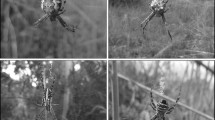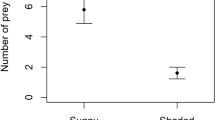Summary
The foraging behavior of orbweaving and sheetweb weaving guilds of spiders was investigated. Orbweavers move among web-sites frequently, but sheetweb weavers do not. A simple model that examines the adaptive advantages of active foraging and sit-and-wait strategies leads to three predictions: 1) Orbweavers should have a simple decision rule for leaving web-sites, 2) Orbweavers' web-sites should have more variable payoffs than do the web-sites of sheetweb weavers, and 3) Orbweavers should have a lower cost of moving than do sheetweb weavers. Field and experimental data bear out each prediction. In addition, analysis of the residence times of spiders at web-sites that are used more than once reveals that members of the two guilds do not compete with each other for web-sites.
The distinction between active foragers and sit-and-wait predators stems from the relative frequency of the decision to leave a foraging site. Thus active foragers are those predators that move often from patch to patch, and sit-and-wait predators are those that leave patches infrequently. In this sense, orbweaving spiders are active foragers and sheetweb weavers are sit-and-wait predators.
Similar content being viewed by others
References
Buskirk RE (1975) Colonility, activity patterns and feeding in a tropical orbweaving spider. Ecology 56:1314–1328
Charnov EL (1976a) Optimal foraging: attack strategy of a mantid. Am Nat 110:141–151
Charnov EL (1976b) Optimal foraging: the marginal value theorem. Theor Popul Biol 9:129–136
Eckhardt RC (1979) The adaptive syndromes of two guilds of insectivorous birds in the Colorado Rocky Mountains. Ecol Monogr 49:129–149
Eisner T, Alsop R, Ettershank G (1964) Adhesiveness of spider silk. Science 146:1058–1061
Enders F (1973) Selection of habitat by the spider Argiope aurantia Lucas (Araneidae). Am Midl Nat 90:47–55
Enders F (1974) Vertical stratification in orb-web spiders (Araneidae, Araneae) and a consideration of other methods of coexistence. Ecology 55:317–328
Enders F (1975) Change of web-site in Argiope spiders (Araneidae). Am Midl Nat 94:484–490
Enders F (1977) Web-site selection by orb-web spiders, particularly Argiope aurantia Lucas. Anim Behav 25:694–712
Fitzpatrick JW (1978) Foraging behavior and adaptive radiation in the avian family Tyrannidae. PhD dissertation, Princeton University
Griffiths D (1980) Foraging costs and relative prey size. Am Nat 116:743–752
Huey RB, Pianka ER (1981) Ecological consequences of foraging mode. Ecology 62:991–999
Janetos AC (1980) Foraging tactics of two guilds of web-spinning spiders. PhD dissertation, Princeton University
Janetos AC (1982) Active foragers vs sit-and-wait predators: a simple model. J Theor Biol (in press)
Kaston BJ (1978) How to know the spiders, 3rd ed. Brown, Dubuque, Iowa
Krebs JR (1978) Optimal foraging: decision rules for predators. In: Krebs JR, Davies NB (eds) Behavioural ecology. Blackwell, London
Krebs JR, Ryan JC, Charnov EL (1974) Hunting by expectation or optimal foraging? A study of patch use by chickadees. Anim Behav 22:953–964
Levi HW (1978) Orb-weaving spiders and their webs. Am Sci 66:734–742
Lucas F, Shaw JTB, Smith SG (1960) The composition of arthropod silk fibroins. Insect Chem Symp 3:208–214
MacArthur RH (1972) Geographical ecology. Harper and Row, New York
MacArthur RH, Pianka ER (1966) On optimal use of a patchy environment. Am Nat 100:603–609
Olive CW (1980) Foraging specializations in orb-weaving spiders. Ecology 61:1133–1144
Olive CW (1981 a) Optimal phenology and body-size of orb-weaving spiders: foraging constraints. Oecologia (Berl) 49:83–87
Olive CW (1981 b) Co-adapted foraging traits in a guild of orbweaving spiders. Oecologia (Berl) 49:88–91
Peakall DB (1962) Rate of incorporation of amino acids into the web proteins of the spider Araneus diadematus. Proc XVI Int Congr Zool 1:13
Peakall DB (1964) Composition, function and glandular origin of the silk fibroins of the spider Araneus diadematus. J Exp Zool 156:345–352
Peakall DB (1971) Conservation of web proteins in the spider Araneus diadematus. J Exp Zool 176:257–264
Peakall DB, Witt PN (1976) The energy budget of an orb webbuilding spider. Comp Biochem Physiol [A] 54:187–190
Pianka ER (1966) Convexity, desert lizards, and spatial heterogeneity. Ecology 47:1055–1059
Pianka ER (1978) Evolutionary ecology. Harper and Row, New York
Pianka ER, Huey RB, Lawlor LR (1979) Niche segregation in desert lizards In: Horn DJ, Stairs GR, Mitchell RD (eds) Analysis of ecological systems. Ohio State University Press, Columbus
Prestwich KN (1977) The energetics of web-building in spiders. Comp Biochem Physiol [A] 57:321–326
Pulliam HR (1974) On the theory of optimal diets. Am Nat 108:59–75
Pyke GH, Pulliam HR, Charnov EL (1977) Optimal foraging: a selective review of theory and tests. Q Rev Biol 52:137–154
Riechert SE (1974) The pattern of local web distribution in a desert spider: mechanisms and seasonal variation. J Anim Ecol 43:733–746
Riechert SE (1976) Web-site selection in the desert spider Agelenopsis aperta. Oikos 27:311–315
Riechert SE (1978) Games spiders play: behavioral variability in territorial disputer. Behav Ecol Sociobiol 3:135–162
Riechert SE (1981) The consequences of being territorial: spiders, a case study. Am Nat 117:871–892
Riechert SE, Tracy CR (1975) Thermal balance and prey availability: bases for a model relating web-site characteristics to spider reproductive success. Ecology 56:265–284
Riechert SE, Reeder WB, Allen TA (1973) Patterns of spider distribution (Agelenopsis aperta (Gertsch)) in desert grassland and recent lava bed habitats, south central New Mexico. J Anim Ecol 42:19–35
Robinson MH (1969) Predatory behavior of Argiope argentata (Fabricius). Am Zool 9:161–173
Root RB (1967) The niche exploitation pattern of the blue-grey gnatcatcher. Ecol Monogr 37:317–350
Ross SM (1970) Applied probability models with optimization applications. Holden-Day, San Francisco
Schoener TW (1969) Optimal size and specialization in constant and fluctuating environments: an energy-time approach. Diversity and stability in ecological systems. Brookhaven Symp Biol 22
Schoener TW (1971) Theory of feeding strategies. Ann Rev Ecol Syst 2:369–404
Siegel S (1956) Nonparametric statistics for the behavioral sciences. McGraw-Hill, New York
Smith JNM (1974a) The food searching behavior of two European thurshes. I. Description and analysis of search paths. Behaviour 48:276–302
Smith JNM (1974b) The food searching behavior of two European thrushes. II. The adaptiveness of the search patterns. Behaviour 49:1–61
Turnbull AL (1964) The search for prey by a web-building spider Achaearanea tepidariorum (C.L. Koch) (Araneae: Theridiidae). Can Entomol 96:568–579
Uetz GW, Biere JM (1980) Prey of Micrathena gracilis (Walckenaer) (Araneae: Araneidae) in comparison with artificial webs and other trapping devices. Bull Br Arachnol Soc 5:101–107
Uetz GW, Burgess JW (1979) Habitat structure and colonial behavior in Metepeira spinipes (Araneae: Araneidae), an orb weaving spider from Mexico. Psyche 86:79–89
Uetz GW, Johnson AD, Schemske DW (1978) Web placement, web structure and prey capture in orb-weaving spiders. Bull Br Arachnol Soc 4:141–148
Wise DH (1975) Food limitation of the spider Linyphia marginata: experimental field studies. Ecology 56:637–646
Witt PN, Reed CF, Peakall DB (1968) A spider's web: problems in regulatory biology. Springer, Berlin Heidelberg New York
Author information
Authors and Affiliations
Rights and permissions
About this article
Cite this article
Janetos, A.C. Foraging tactics of two guilds of web-spinning spiders. Behav Ecol Sociobiol 10, 19–27 (1982). https://doi.org/10.1007/BF00296392
Received:
Accepted:
Issue Date:
DOI: https://doi.org/10.1007/BF00296392




